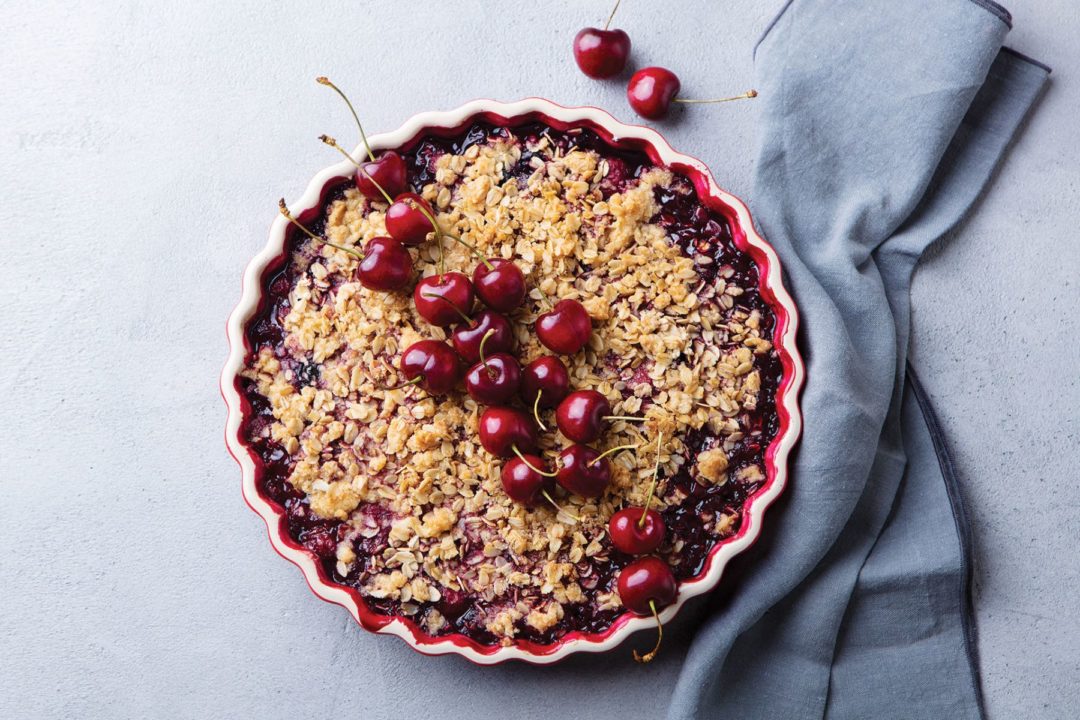Accelerated by millions of Americans under quarantine recommendations, the baking renaissance of 2020 has been shared on social media and subsequently seen in empty shelves in stores. From flour to yeast shortages, baking has cooked up closeness that made dealing with a pandemic a bit sweeter. The outlook on the category is growing too. Globally, the baking ingredient market is expected to reach $3 billion by 2027, growing at a CAGR of 3.8% over the analysis period of 2020-2027 (1).
“With many children home from school, parents are given the opportunity to spend more time teaching their kids about the science of baking—reading, measuring, weighing, and following a sequence,” says Joel Hansen, President of India Tree. “The reward is a tasty treat for the kids, and an opportunity for parents to reminisce by re-creating some of their own childhood favorites.”
And it’s not all about indulgence, Hansen says. Consumers are buying products with simple ingredients that are healthy and sustainable.
Sustainable Baking
Natural Product consumers are interested in sustainable businesses—ones that make the extra effort. “We’ve received a lot of customer inquiries throughout this period of people being at home that revolve around the ingredients that go into our products, where they come from, how they’re sourced, and the practices that go into their cultivation and processing,” says Morovits. “Consumers are actively trying to confirm that the products they’re using are good for them and their families.”With ethics in mind, it’s essential that retailers choose brands that connect on a meaningful level with the consumer. For India Tree, that means transparency through the supply chain. “Every part of the cane is put to good use,” says Hansen. “The leaves are used for thatching roofs or covering the fields after harvesting to conserve moisture. The scum from the purifying of the sugar is returned to the planters for fertilizer. The bagasse, or fiber, is burned for fuel,” says Hansen. “The vapor produced in the evaporation process generates energy for manufacture and for sale to the national grid. Ethanol is also a by‐product and is used to generate energy, or in some cases for the making of rum.”#QuarantineBaking Trends
Start with flour. There’s a slew of alternative flours on the market ranging from Almond, Coconut, Chickpea to Oat flour—and many more in between—that boast functional benefits. Yolélé offers a gluten-free ancient West African grain called Fonio. New to the American and global markets, fonio can be used to make a plethora of dishes such as couscous, cereals, brownies, cookies and more. Next, the company will roll out a gluten-free fonio flour.
“Fonio is low on the glycemic index, making it an appropriate ingredient for people living with diabetes,” says Phillip Teverow, CEO + Co-Founder of Yolélé. “ That same quality also relates to slow, time-released digestion of nutrients, which makes fonio useful for extending satiety.”
Cappello’s is also on the alternative flour train. The company introduced an almond flour based cookie dough. The dough is grain-free, vegan, paleo-friendly, uses non-GMO ingredients and is made with maple syrup, coconut oil and selectively sourced chocolate morsels with just a sprinkling of course sea salt. “We have seen our core consumer shift their interest to items that are plant-based and we certainly don’t see that stopping in the year to come,” says Stacey Marcellus, Co-Founder and Co-CEO of Cappello’s. “We’ve also seen them look for items that use alternative flours, as many are looking to stay healthy and reduce inflammation. Almond flour is not only great for making our products grain-free, but really delivers on giving customers a healthy, delicious option that never compromises on taste and texture.”
Sweeten up. WholeFoods Magazine took a deep dive into the natural sweeteners market in October, and it’s clear that consumers are looking for healthier options. Products like monk fruit, maple syrup, honey, and stevia are a few of the trending sweeteners. India Tree works in the exotic sugar market to address those concerns. Its top-selling baking sugars are Caster Sugar, Demerara, and Dark Muscovado—all used for a range of recipes from custards to mousses.
“Fair Trade, Non-GMO Project Verified, and Kosher certified, these exotic sugars are milled from cane grown on the island of Mauritius on family-owned plantations and small farms,” says Hansen. “The molasses is never removed from Demerara and Muscovado Sugars, unlike refined brown sugars, which have it taken out early on during the refining process, then added back in at a later stage for color and flavor.”
Add touch of Vanilla. Offered in a no-sugar- added option, Nielsen Massey Vanillas provides pure vanilla extracts that are Certified Gluten-Free, Non-GMO, Kosher and allergy free. The company’s number one selling product is its Madagascar Bourbon Pure Vanilla Extract, followed closely by Madagascar Bourbon Pure Vanilla Paste, Pure Vanilla Extract and Pure Vanilla Paste, says Matt Nielsen, Vice President of Strategic Initiatives of Nielsen-Massey Vanillas.
“There are many benefits of vanilla extract when it comes to baking,” Nielsen says. “Vanilla acts as a natural flavor enhancer and helps blend flavors together. For example, in chocolate, vanilla adds a depth of flavor and makes your chocolate taste more like chocolate. Depending on the recipe, vanilla can also be used as a sugar replacement.”
Don’t forget the chocolate. The no-and-low sugar trend continues, even when it comes to chocolate. Artisan Kettle’s No Sugar Added Dark Chocolate Chips have seen a spike in consumer interest. The brand sells a line of Allergen Free, Certified Organic by QAI, Fair Trade Certified, Vegan, GMO Free, Naturally Gluten Free, Dairy, Soy and Nut Free, Kosher Pareve, chocolate chips and baking bars.
“Dark chocolate is known for its health benefits but our No Sugar Added version works well with any diet because it is also vegan, Kosher Pareve, and allergen-free,” says Dan Morovits, Brand Manager at Artisan Kettle. “They can be used in Keto recipes or you can throw a handful on top of your ice cream. Consumers are able to indulge themselves because of the amazing taste, but not worry about falling off their diets or raising their blood sugar levels.”
Ready-made mmm
For the busy consumers looking for a quick fix, products like Good Dee’s baking mixes might do the trick. Good Dees brownie mix and cornbread mix are both sugar free, gluten free, low carb and contain zero added sugars. Suitable for diabetics and consumers looking to decrease sugar intake, Good Dees mixes are a convenient option for the busy parent.And for the consumers who don’t have a moment to bake at all, Smart Baking Company’s Smartbuns may solve the sweet craving. They’re zero net carbs and keto friendly and contain 9 grams of protein and 11 grams of fiber. “We’ve seen people get so creative with them, using them for everything from bread pudding to French toast, in addition to amazing sandwich creations,” says Dave Heuvel, Co-founder and Vice President of Sales at Smart Baking Company. “One important thing about all of our baked goods is sugar. All of our products contain zero carbs from sugar or starch. We accomplish this by using monk fruit and erythritol, which add sweetness without the calories.”4 Merchandising Strategies
- Get social. “COVID-19 has increased consumer dependence on social media as a destination for information and inspiration from the brands they trust,” says Nielsen. “Brands, in turn, should respond by ensuring the information they share on social media is both informative and useful for consumers – such as sharing certifications and label information or product recommendations for recipes. We recently launched a new campaign and Instagram sweepstakes, Bake to Share, that encourages baking during the holidays as a way to foster joy.”
- “Highlighting a product’s premium attributes has been proven to work. Shelf talkers can be helpful if they are able to communicate a ‘clean, better for you ingredients’ message,” says Hansen.
- Cross merchandize. “Sometimes cross merchandising can be successful: displaying caster sugar in the iced tea section, for example, or Demerara in the coffee section, can entice shoppers into trying new ingredient combinations,” adds Hansen. “Recipes can be effective, especially if they suggest uncomplicated, easy-to-prep and simple-to-serve results.”
- Get back to basics. The Healthy Grocer plans to market baking ingredients with “Back to Basics” themed end caps. “Rather than focusing on holiday baking, we will focus on the basics of baking,” says Kiskis. Although holidays might look a bit different this year due to the pandemic, cooking always brings us together. “With families being distanced I don't think there will be that run on holiday baking as their normally would be. Who knows though? Some people might be inspired to bake cookies by the dozen and drop them off to their neighbors as a sign of comradery.” WF
- “Global Baking Ingredients Industry“ Global Industry Analysts, Posted 7/2020, Accessed 9/2020. https://www.reportlinker.com/p05899125/Global-Baking-Ingredients-Industry.html?utm_source=GNW.










